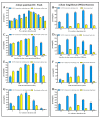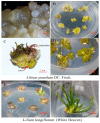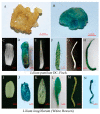Establishment of Efficient Genetic Transformation Systems and Application of CRISPR/Cas9 Genome Editing Technology in Lilium p umilum DC. Fisch. and Lilium l ongiflorum White Heaven
- PMID: 31207994
- PMCID: PMC6627044
- DOI: 10.3390/ijms20122920
Establishment of Efficient Genetic Transformation Systems and Application of CRISPR/Cas9 Genome Editing Technology in Lilium p umilum DC. Fisch. and Lilium l ongiflorum White Heaven
Abstract
Lilium spp. is a bulb flower with worldwide distribution and unique underground organs. The lack of an efficient genetic transformation system for Lilium has been an international obstacle. Because existing model plants lack bulbs, bulb-related gene function verification studies cannot be carried out in model plants. Here, two stable and efficient genetic transformation systems based on somatic embryogenesis and adventitious bud regeneration were established in two Lilium species. Transgenic plants and T-DNA insertion lines were confirmed by β-glucuronidase (GUS) assay, polymerase chain reaction (PCR) and Southern blot. After condition optimization, transformation efficiencies were increased to 29.17% and 4% in Lilium pumilum DC. Fisch. and the Lilium longiflorum 'White Heaven', respectively. To further verify the validity of these transformation systems and apply the CRISPR/Cas9 (Clustered Regularly Interspaced Short Palindromic Repeats (CRISPR)-associated protein 9) technology in Lilium, the LpPDS gene in the two Lilium species was knocked out. Completely albino, pale yellow and albino-green chimeric mutants were observed. Sequence analysis in the transgenic lines revealed various mutation patterns, including base insertion, deletion and substitution. These results verified the feasibility and high efficiency of both transformation systems and the successful application of the CRISPR/Cas9 system to gene editing in Lilium for the first time. Overall, this study lays an important foundation for gene function research and germplasm improvement in Lilium spp.
Keywords: CRISPR/Cas9; Lilium; Phytoene desaturase (PDS); genetic transformation; somatic embryogenesis.
Conflict of interest statement
The authors declare that they have no conflict of interest.
Figures







References
-
- Grassotti A., Gimelli F., Grassotti A., Burchi G. Bulb and cut flower production in the genus Lilium: Current status and the future. Acta Hortic. 2011;900:21–36. doi: 10.17660/ActaHortic.2011.900.1. - DOI
-
- Liao W.Y., Lin L.F., Lin M.D., Hsieh S.C., Li A.Y., Tsay Y.S., Chou M.L. Overexpression of Lilium formosanum MADS-box (LFMADS) causing floral defects while promoting flowering in Arabidopsis thaliana, whereas only affecting floral transition time in Nicotiana tabacum. Int. J. Mol. Sci. 2018;19:2217. doi: 10.3390/ijms19082217. - DOI - PMC - PubMed
-
- Parmar N., Singh K.H., Sharma D., Singh L., Kumar P., Nanjundan J., Khan Y.J., Chauhan D.K., Thakur A.K. Genetic engineering strategies for biotic and abiotic stress tolerance and quality enhancement in horticultural crops: A comprehensive review. Biotech. 2017;7:239. doi: 10.1007/s13205-017-0870-y. - DOI - PMC - PubMed
MeSH terms
Substances
Grants and funding
LinkOut - more resources
Full Text Sources
Miscellaneous

